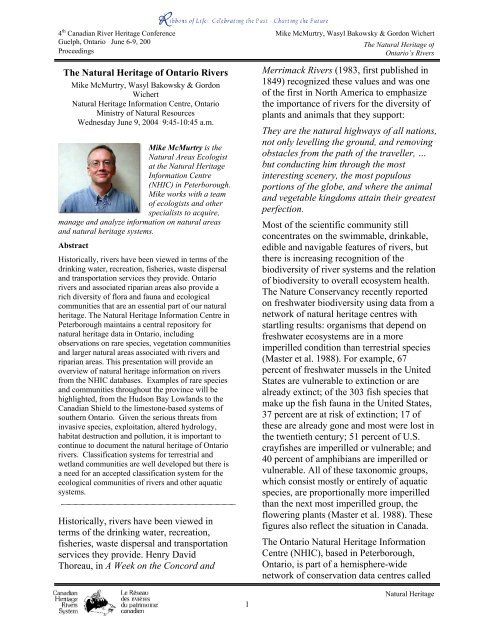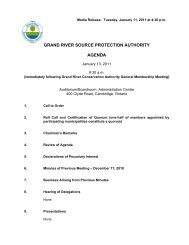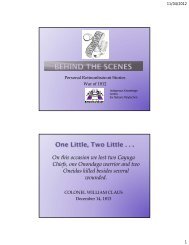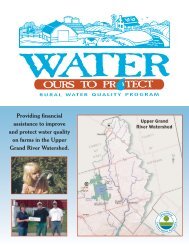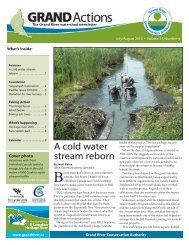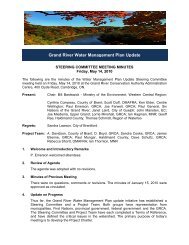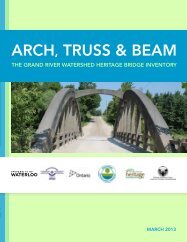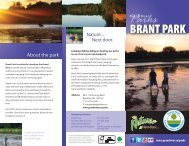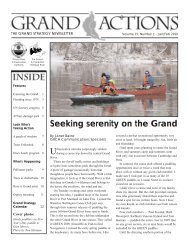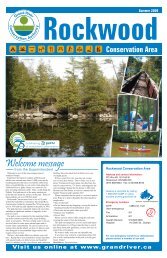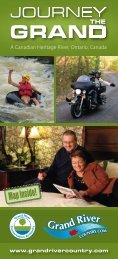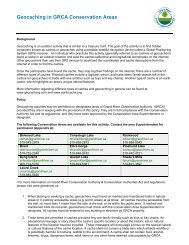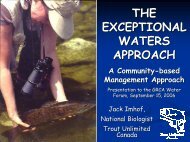The Natural Heritage of Ontario Rivers - Grand River Conservation ...
The Natural Heritage of Ontario Rivers - Grand River Conservation ...
The Natural Heritage of Ontario Rivers - Grand River Conservation ...
You also want an ePaper? Increase the reach of your titles
YUMPU automatically turns print PDFs into web optimized ePapers that Google loves.
4 th Canadian <strong>River</strong> <strong>Heritage</strong> Conference Mike McMurtry, Wasyl Bakowsky & Gordon Wichert<br />
Guelph, <strong>Ontario</strong> June 6-9, 200<br />
<strong>The</strong> <strong>Natural</strong> <strong>Heritage</strong> <strong>of</strong><br />
Proceedings<br />
<strong>Ontario</strong>’s <strong><strong>River</strong>s</strong><br />
<strong>The</strong> <strong>Natural</strong> <strong>Heritage</strong> <strong>of</strong> <strong>Ontario</strong> <strong><strong>River</strong>s</strong><br />
Mike McMurtry, Wasyl Bakowsky & Gordon<br />
Wichert<br />
<strong>Natural</strong> <strong>Heritage</strong> Information Centre, <strong>Ontario</strong><br />
Ministry <strong>of</strong> <strong>Natural</strong> Resources<br />
Wednesday June 9, 2004 9:45-10:45 a.m.<br />
Mike McMurtry is the<br />
<strong>Natural</strong> Areas Ecologist<br />
at the <strong>Natural</strong> <strong>Heritage</strong><br />
Information Centre<br />
(NHIC) in Peterborough.<br />
Mike works with a team<br />
<strong>of</strong> ecologists and other<br />
specialists to acquire,<br />
manage and analyze information on natural areas<br />
and natural heritage systems.<br />
Abstract<br />
Historically, rivers have been viewed in terms <strong>of</strong> the<br />
drinking water, recreation, fisheries, waste dispersal<br />
and transportation services they provide. <strong>Ontario</strong><br />
rivers and associated riparian areas also provide a<br />
rich diversity <strong>of</strong> flora and fauna and ecological<br />
communities that are an essential part <strong>of</strong> our natural<br />
heritage. <strong>The</strong> <strong>Natural</strong> <strong>Heritage</strong> Information Centre in<br />
Peterborough maintains a central repository for<br />
natural heritage data in <strong>Ontario</strong>, including<br />
observations on rare species, vegetation communities<br />
and larger natural areas associated with rivers and<br />
riparian areas. This presentation will provide an<br />
overview <strong>of</strong> natural heritage information on rivers<br />
from the NHIC databases. Examples <strong>of</strong> rare species<br />
and communities throughout the province will be<br />
highlighted, from the Hudson Bay Lowlands to the<br />
Canadian Shield to the limestone-based systems <strong>of</strong><br />
southern <strong>Ontario</strong>. Given the serious threats from<br />
invasive species, exploitation, altered hydrology,<br />
habitat destruction and pollution, it is important to<br />
continue to document the natural heritage <strong>of</strong> <strong>Ontario</strong><br />
rivers. Classification systems for terrestrial and<br />
wetland communities are well developed but there is<br />
a need for an accepted classification system for the<br />
ecological communities <strong>of</strong> rivers and other aquatic<br />
systems.<br />
Historically, rivers have been viewed in<br />
terms <strong>of</strong> the drinking water, recreation,<br />
fisheries, waste dispersal and transportation<br />
services they provide. Henry David<br />
Thoreau, in A Week on the Concord and<br />
Merrimack <strong><strong>River</strong>s</strong> (1983, first published in<br />
1849) recognized these values and was one<br />
<strong>of</strong> the first in North America to emphasize<br />
the importance <strong>of</strong> rivers for the diversity <strong>of</strong><br />
plants and animals that they support:<br />
<strong>The</strong>y are the natural highways <strong>of</strong> all nations,<br />
not only levelling the ground, and removing<br />
obstacles from the path <strong>of</strong> the traveller, …<br />
but conducting him through the most<br />
interesting scenery, the most populous<br />
portions <strong>of</strong> the globe, and where the animal<br />
and vegetable kingdoms attain their greatest<br />
perfection.<br />
Most <strong>of</strong> the scientific community still<br />
concentrates on the swimmable, drinkable,<br />
edible and navigable features <strong>of</strong> rivers, but<br />
there is increasing recognition <strong>of</strong> the<br />
biodiversity <strong>of</strong> river systems and the relation<br />
<strong>of</strong> biodiversity to overall ecosystem health.<br />
<strong>The</strong> Nature Conservancy recently reported<br />
on freshwater biodiversity using data from a<br />
network <strong>of</strong> natural heritage centres with<br />
startling results: organisms that depend on<br />
freshwater ecosystems are in a more<br />
imperilled condition than terrestrial species<br />
(Master et al. 1988). For example, 67<br />
percent <strong>of</strong> freshwater mussels in the United<br />
States are vulnerable to extinction or are<br />
already extinct; <strong>of</strong> the 303 fish species that<br />
make up the fish fauna in the United States,<br />
37 percent are at risk <strong>of</strong> extinction; 17 <strong>of</strong><br />
these are already gone and most were lost in<br />
the twentieth century; 51 percent <strong>of</strong> U.S.<br />
crayfishes are imperilled or vulnerable; and<br />
40 percent <strong>of</strong> amphibians are imperilled or<br />
vulnerable. All <strong>of</strong> these taxonomic groups,<br />
which consist mostly or entirely <strong>of</strong> aquatic<br />
species, are proportionally more imperilled<br />
than the next most imperilled group, the<br />
flowering plants (Master et al. 1988). <strong>The</strong>se<br />
figures also reflect the situation in Canada.<br />
<strong>The</strong> <strong>Ontario</strong> <strong>Natural</strong> <strong>Heritage</strong> Information<br />
Centre (NHIC), based in Peterborough,<br />
<strong>Ontario</strong>, is part <strong>of</strong> a hemisphere-wide<br />
network <strong>of</strong> conservation data centres called<br />
1<br />
<strong>Natural</strong> <strong>Heritage</strong>
4 th Canadian <strong>River</strong> <strong>Heritage</strong> Conference Mike McMurtry, Wasyl Bakowsky & Gordon Wichert<br />
Guelph, <strong>Ontario</strong> June 6-9, 200<br />
<strong>The</strong> <strong>Natural</strong> <strong>Heritage</strong> <strong>of</strong><br />
Proceedings<br />
<strong>Ontario</strong>’s <strong><strong>River</strong>s</strong><br />
NatureServe. Most Canadian provinces, as<br />
well as the Yukon Territories, now have<br />
such a centre. <strong>The</strong> NHIC acts as a central<br />
repository for natural heritage information<br />
and data in <strong>Ontario</strong> and makes this<br />
information available for conservation<br />
planning and action. <strong>The</strong> primary focus is on<br />
organisms and ecological communities that<br />
are rare or at risk. <strong>The</strong> NHIC also maintains<br />
a database on natural areas, including those<br />
recognized for their aquatic biodiversity.<br />
This paper will present a summary <strong>of</strong> the<br />
information available at the NHIC on the<br />
biodiversity <strong>of</strong> <strong>Ontario</strong> rivers and on areas<br />
where this biodiversity is concentrated. <strong>The</strong><br />
emphasis will be on species that are<br />
provincially rare and/or tracked by the<br />
NHIC (because they may become rare). It<br />
will describe some examples <strong>of</strong> <strong>Ontario</strong><br />
rivers with outstanding biodiversity and<br />
illustrate examples <strong>of</strong> species and plant<br />
communities associated with rivers. Some <strong>of</strong><br />
these rivers are part <strong>of</strong> the Canadian<br />
<strong>Heritage</strong> <strong>River</strong> System and others are not.<br />
We will also describe new work to classify<br />
riverine ecosystems so that we can identify<br />
which ones are most important for<br />
conservation <strong>of</strong> flora and fauna. While there<br />
are fewer data on aquatic biodiversity<br />
compared to those for terrestrial, there is<br />
nevertheless a wealth <strong>of</strong> information to draw<br />
on.<br />
Distribution <strong>of</strong> Biota Associated with<br />
<strong><strong>River</strong>s</strong><br />
At the time <strong>of</strong> writing, the NHIC has records<br />
on 2265 element occurrences for plants and<br />
animals that are associated with rivers and<br />
an additional 200 element occurrences for<br />
plant communities (Figure 1). Not all <strong>of</strong> the<br />
species reported here are strictly aquatic; we<br />
have included those that occupy wetlands<br />
along rivers, streams and creeks as well. <strong>The</strong><br />
reptiles and mammals included rely on<br />
riverine habitat for a critical portion <strong>of</strong> their<br />
habitat. An element occurrence is roughly<br />
equivalent to a population – it is the space<br />
where a single interbreeding occurrence is<br />
found. <strong>The</strong>re can be many observations at<br />
different times in the NHIC database for a<br />
given element occurrence. An example <strong>of</strong> an<br />
element occurrence would be a patch <strong>of</strong><br />
Meadow-beauty, Rhexia virginica, along a<br />
river shoreline, or a population <strong>of</strong> Redside<br />
Dace, Clinostomus elongatus, in a reach <strong>of</strong><br />
the Rouge <strong>River</strong>.<br />
Most <strong>of</strong> these occurrences are in southern<br />
<strong>Ontario</strong>: this is both because the biodiversity<br />
is higher in southern rivers and because<br />
there has been more sampling activity in the<br />
south. Vascular plants are the best<br />
represented in the database, followed by<br />
odonates, fish, birds and molluscs (Table 1).<br />
Some insect groups known to be abundant in<br />
rivers are not represented at all: stoneflies<br />
(Plecoptera), mayflies (Ephemeroptera) and<br />
midges (Chironomidae), for example. This<br />
reflects where the NHIC expertise lies and<br />
what scientific disciplines have been<br />
involved in conservation. <strong>The</strong>re may be data<br />
on rare mayflies in <strong>Ontario</strong> that would<br />
benefit our centre and our knowledge <strong>of</strong><br />
aquatic biodiversity but they have not yet<br />
been discovered and incorporated.<br />
Most <strong>of</strong> these species are provincially rare<br />
(S-Ranked) and some are globally rare (G-<br />
Ranked). A high proportion <strong>of</strong> the nonvascular<br />
plants and molluscs are globally<br />
rare (Table 2). A high proportion <strong>of</strong> the<br />
species have been identified as being at risk<br />
either at the federal (Committee on the<br />
Status <strong>of</strong> Endangered Wildlife in Canada,<br />
COSEWIC) or provincial level (Committee<br />
on Species at Risk in <strong>Ontario</strong>, COSSARO).<br />
Almost all <strong>of</strong> the amphibians and reptiles<br />
tracked by the NHIC, and associated with<br />
riverine habitats, are designated as being at<br />
risk by COSEWIC and COSSARO.<br />
Examples include Queen Snake (Regina<br />
septemvittata), Spiny S<strong>of</strong>tshell (Apalone<br />
spinifera) and Fowler’s Toad (Bufo fowleri).<br />
2<br />
<strong>Natural</strong> <strong>Heritage</strong>
4 th Canadian <strong>River</strong> <strong>Heritage</strong> Conference Mike McMurtry, Wasyl Bakowsky & Gordon Wichert<br />
Guelph, <strong>Ontario</strong> June 6-9, 200<br />
<strong>The</strong> <strong>Natural</strong> <strong>Heritage</strong> <strong>of</strong><br />
Proceedings<br />
<strong>Ontario</strong>’s <strong><strong>River</strong>s</strong><br />
Some <strong>of</strong> the species that are represented in<br />
the NHIC database are well-known species,<br />
such as Redside Dace, Bald Eagle<br />
(Haliaeetus leucocephalus), Lake Sturgeon<br />
(Acipenser fulvescens)and Wood Turtle<br />
(Clemmys insculpta)and others are lesser<br />
known, such as Emory’s Sedge (Carex<br />
emoryi), found in shoreline meadows along<br />
the Rainy, Sydenham, Thames and <strong>Grand</strong><br />
rivers (Table 3).<br />
<strong><strong>River</strong>s</strong> with Outstanding Biodiversity<br />
Three rivers stand head and shoulders above<br />
other rivers in our database in terms <strong>of</strong> the<br />
number <strong>of</strong> observations <strong>of</strong> rare species.<br />
<strong>The</strong>y are the <strong>Grand</strong>, Thames (Figure 2) and<br />
Sydenham rivers. All <strong>of</strong> these rivers have a<br />
large drainage area and most <strong>of</strong> their extent<br />
is in Ecoregion 7E, or Carolinian Canada, a<br />
region known not only for its variety <strong>of</strong><br />
species, but also for the number <strong>of</strong> species<br />
and spaces at risk. Recovery teams have<br />
been established for all <strong>of</strong> these rivers.<br />
<strong>The</strong> <strong>Grand</strong> <strong>River</strong> is aptly named; it has a<br />
huge watershed <strong>of</strong> over 7000 km² (Portt et<br />
al. 2003), the largest in southern <strong>Ontario</strong>,<br />
and encompasses many tributaries including<br />
the Speed, Eramosa, Nith and Conestogo<br />
rivers. Habitats for aquatic organisms are<br />
diverse. Headwaters with variable flow are<br />
underlain with clay and glacial till; middle<br />
reaches have both cool and coldwater<br />
habitats and numerous areas <strong>of</strong> groundwater<br />
discharge; and the lower reaches are highly<br />
productive with deep pools and extensive<br />
littoral zones. Over one-half <strong>of</strong> the 158<br />
freshwater fishes known to occur in <strong>Ontario</strong><br />
have been documented in the <strong>Grand</strong> <strong>River</strong><br />
watershed, including six species designated<br />
as Special Concern, Threatened or<br />
Endangered by COSEWIC (Portt et al.<br />
2003). It is justifiably a Canadian <strong>Heritage</strong><br />
<strong>River</strong>. An example <strong>of</strong> an outstanding natural<br />
area associated with the <strong>Grand</strong> <strong>River</strong> is the<br />
<strong>Grand</strong> <strong>River</strong> Forests Area <strong>of</strong> <strong>Natural</strong> and<br />
Scientific Interest (ANSI) and its contiguous<br />
neighbour, the Spottiswood Lakes ANSI<br />
(Allen et al. 2000). <strong>The</strong> <strong>Grand</strong> <strong>River</strong> Forests<br />
ANSI includes seepage slope wetlands,<br />
upland mature hardwoods, riparian<br />
meadows, shallow water habitat, and even<br />
some tallgrass prairie. Twenty-two species<br />
<strong>of</strong> vascular plants found within the two<br />
ANSIs are considered provincially rare, and<br />
one sedge, Carex schweinitzii, is globally<br />
rare. <strong>The</strong> Threatened (COSEWIC and<br />
COSSARO) Queen Snake and Jefferson’s<br />
Salamander, Ambystoma jeffersonianum<br />
(COSEWIC) are both found within these<br />
ANSIs and the <strong>Grand</strong> <strong>River</strong> proper supports<br />
the Wavy-rayed Lampmussel, Lampsilis<br />
fasciola, a freshwater mussel designated as<br />
Endangered by COSEWIC (Allen et al.<br />
2000).<br />
Another jewel, in term <strong>of</strong> rare aquatic<br />
species, is the Sydenham <strong>River</strong>. Like the<br />
<strong>Grand</strong>, this river is located in the speciesrich<br />
Carolinian Zone, and supports the<br />
greatest diversity <strong>of</strong> freshwater mussels in<br />
all <strong>of</strong> Canada (Dextrase et al. 2002). Thirty<br />
four species <strong>of</strong> mussels and 80 species <strong>of</strong><br />
fish have been documented here. Freshwater<br />
mussels in <strong>Ontario</strong> are under threat by the<br />
invasion <strong>of</strong> non-native species and water<br />
quality impairment such as siltation and<br />
over-enrichment with nutrients from run<strong>of</strong>f<br />
from farms and urban areas. <strong>The</strong><br />
Endangered Rayed Bean, Villosa fabalis,<br />
(Figure 3) is found nowhere else in Canada<br />
and only in a few other locations in North<br />
America Dextrase et al. 2002). During<br />
fieldwork conducted in the summer <strong>of</strong> 2003<br />
in support <strong>of</strong> the Sydenham <strong>River</strong> Recovery<br />
Plan, Colin Jones, <strong>of</strong> the NHIC, and Peter<br />
Burke found a species <strong>of</strong> dragonfly new to<br />
Canada along the Sydenham <strong>River</strong>: it is<br />
called the Mocha Emerald, Somatochlora<br />
linearis (Figure 4).<br />
Some rivers are significant, not for the<br />
number <strong>of</strong> species they support, but because<br />
they provide a large proportion <strong>of</strong> the habitat<br />
3<br />
<strong>Natural</strong> <strong>Heritage</strong>
4 th Canadian <strong>River</strong> <strong>Heritage</strong> Conference Mike McMurtry, Wasyl Bakowsky & Gordon Wichert<br />
Guelph, <strong>Ontario</strong> June 6-9, 200<br />
<strong>The</strong> <strong>Natural</strong> <strong>Heritage</strong> <strong>of</strong><br />
Proceedings<br />
<strong>Ontario</strong>’s <strong><strong>River</strong>s</strong><br />
for one or a few species. <strong>The</strong> English and<br />
Winnipeg rivers, for example, have a<br />
disproportionately large number <strong>of</strong> Bald<br />
Eagle nesting locations compared to other<br />
rivers. <strong>The</strong> Ottawa <strong>River</strong> provides habitat<br />
for two species <strong>of</strong> fish that are under threat<br />
in <strong>Ontario</strong>: the Lake Sturgeon and <strong>River</strong><br />
Redhorse, Moxostoma carinatum. Both <strong>of</strong><br />
these species spawn in the rapids <strong>of</strong> large<br />
rivers. <strong>The</strong> Ottawa <strong>River</strong> near Fitzroy<br />
Provincial Park also has unique shoreline<br />
vegetation communities which can<br />
withstand annual ice scouring, periodic<br />
flooding and drought: Isoetes riparia,<br />
Helenium autumnale, Agalinus tenuifolia<br />
and Alisma gramineum are a few <strong>of</strong> the<br />
provincially rare species present (D.F.<br />
Brunton, pers. comm.). Many other rivers in<br />
<strong>Ontario</strong> are worthy <strong>of</strong> praise for the plants<br />
and animals they support; rivers frequently<br />
cited in the NHIC database include the St.<br />
Clair, Maitland, Ausauble, Humber, Rouge,<br />
Credit, and Canard in the south, and the<br />
Petawawa, Groundhog and Winisk further<br />
north.<br />
<strong>River</strong>ine Processes That Shape Ecological<br />
Communities<br />
<strong>The</strong> energy associated with river systems<br />
creates a dynamic shoreline environment,<br />
particularly in areas where combinations <strong>of</strong><br />
hydrology, topography and stream gradient<br />
are responsible for periodic flooding and<br />
associated flood-scour, or where rocks<br />
outcrop along major topographic breaks.<br />
Such areas are <strong>of</strong>ten further affected in<br />
winter by ice-push and ice-scour. As a<br />
consequence <strong>of</strong> this disturbance activity,<br />
active river shorelines create special habitats<br />
which <strong>of</strong>ten support rare flora and fauna.<br />
Some <strong>of</strong> the unique habitats associated with<br />
river shores include flood-scoured meadows,<br />
flood-scoured rocky shores, rapids,<br />
seepages, eroding banks, and canyons.<br />
Tallgrass prairie is a provincially rare<br />
vegetation type that can be associated with<br />
rivers; it occurs along the Ausable <strong>River</strong> and<br />
<strong>Grand</strong> <strong>River</strong> in the south, and the Rainy and<br />
English <strong><strong>River</strong>s</strong> in north-western <strong>Ontario</strong>.<br />
Alvar vegetation occurs along the Ottawa<br />
<strong>River</strong>, where it is dependent on flood-scour<br />
and ice-push to maintain open conditions.<br />
In northern <strong>Ontario</strong>, many rivers have rocky<br />
rapids and canyons which support<br />
assemblages <strong>of</strong> arctic-alpine plant species.<br />
<strong>The</strong> Maitland <strong>River</strong> in southern <strong>Ontario</strong> also<br />
has relict arctic-alpine species. Additional<br />
information on the unique habitats and flora<br />
<strong>of</strong> northern rivers is available in the NHIC<br />
Winter 2004 Newsletter (Bakowsky 2004).<br />
Classification <strong>of</strong> <strong>River</strong>ine Systems<br />
If we are to identify and protect the types <strong>of</strong><br />
riverine systems that are associated with<br />
diverse communities <strong>of</strong> plants and animals,<br />
we have to understand the physical<br />
conditions that create the system and the<br />
type <strong>of</strong> watershed where they are located.<br />
Ideally this could be done with basic<br />
landscape data that are available for the<br />
whole province. <strong>The</strong> NHIC has been<br />
involved in work to create a classification<br />
system that will be useful in identifying<br />
riverscape units for conservation purposes.<br />
<strong><strong>River</strong>s</strong> can be viewed as part <strong>of</strong> a continuum<br />
connecting drainage areas and upper<br />
tributaries with downstream receiving<br />
waters such as embayments, wetlands, and<br />
lakes. <strong>The</strong> form <strong>of</strong> river reaches is<br />
determined primarily by the upstream<br />
geomorphic regime as modified by climaterelated<br />
phenomena. <strong>The</strong> ecology <strong>of</strong> river<br />
reaches is strongly influenced by the<br />
upstream climatic regime and may be<br />
modified by the presence and movements <strong>of</strong><br />
aquatic organisms including invertebrates,<br />
amphibians, birds, fishes and by physical<br />
phenomena, including seiches and upwelling<br />
events along the Great Lakes coast, for<br />
example.<br />
4<br />
<strong>Natural</strong> <strong>Heritage</strong>
4 th Canadian <strong>River</strong> <strong>Heritage</strong> Conference Mike McMurtry, Wasyl Bakowsky & Gordon Wichert<br />
Guelph, <strong>Ontario</strong> June 6-9, 200<br />
<strong>The</strong> <strong>Natural</strong> <strong>Heritage</strong> <strong>of</strong><br />
Proceedings<br />
<strong>Ontario</strong>’s <strong><strong>River</strong>s</strong><br />
Headwater areas and small rivers are<br />
strongly linked to the landscape by their<br />
high surface area to volume ratio.<br />
Headwater domains typically receive much<br />
allochthonous detritus (organic debris<br />
formed outside the river) where riparian<br />
vegetation exists. Resident communities<br />
usually include invertebrates that feed on<br />
coarse particulate organic matter (Vannote<br />
et al. 1980). Fish species in headwater areas<br />
generally prefer cold temperatures, feed on<br />
insects and deposit their eggs in the<br />
substrate. <strong>The</strong>se areas exhibit low overall<br />
biodiversity and generally low in-stream<br />
plant diversity because little sunlight reaches<br />
the water.<br />
As stream size increases, a reduction in<br />
allochthonous inputs from terrestrial systems<br />
coincides with increased autochthonous<br />
primary production (production by plants<br />
within the river) and organic transport from<br />
upstream. Invertebrate communities are<br />
characterized by species that utilize coarse<br />
and fine particulate organic matter as well as<br />
those that scrape algae from attached<br />
surfaces (Vannote et al. 1980). Insect and<br />
fish-eating fish species dominate the middle<br />
reaches. In relatively undisturbed rivers,<br />
resident fish species in these larger sections<br />
prefer cool and warm water temperatures<br />
and prefer the stream margins or benthic<br />
habitats for feeding and breeding.<br />
Lower reaches are generally characterized<br />
by warm, daily stable water temperatures<br />
and slow currents. Surface-to-volume ratios<br />
are such that large lower reaches have<br />
relatively little interaction with the<br />
landscape on an ongoing basis. Landscape<br />
interactions are generally restricted to<br />
episodic flood events when the river waters<br />
spread across the floodplain. Most nutrients<br />
drift down from upstream and some come<br />
from autochthonous primary production.<br />
Invertebrates typically filter nutrients from<br />
transport or gather them from sediment<br />
(Vannote et al. 1980). In larger rivers, semipelagic<br />
(open water) systems with<br />
characteristic phytoplankton and<br />
zooplankton species persist with<br />
planktivorous fish, in addition to the<br />
carnivorous fish species from the middle<br />
reaches.<br />
Areas <strong>of</strong> high biodiversity persist where<br />
conditions support the feeding and<br />
reproduction <strong>of</strong> many species. Such locales<br />
coincide with populations <strong>of</strong> large, longlived,<br />
late-maturing benthic species that<br />
integrate ecosystem processes (Regier et al.<br />
1989). Examples <strong>of</strong> complex habitat such as<br />
accumulations <strong>of</strong> large woody debris, rocky<br />
rapids, large macrophyte beds, and dunes<br />
(bars) in sandy rivers, create the complex <strong>of</strong><br />
ecosystem processes that support high levels<br />
<strong>of</strong> biodiversity. Centres <strong>of</strong> biodiversity and<br />
ecological communities cannot be related to<br />
physical processes <strong>of</strong> rivers in a linear and<br />
strongly predictive way, but some<br />
community-habitat regularities may be<br />
observed. For example, key headwater<br />
species require groundwater discharge to<br />
enhance spawning success. Groundwater<br />
discharge zones relate to areas with<br />
relatively permeable geology and mediumto-high<br />
stream gradient.<br />
<strong>River</strong> systems were classified along four<br />
dimensions: watershed position (and size),<br />
geological permeability, gradient, and water<br />
storage potential (Wichert et al. 2004). This<br />
classification should group river systems<br />
with similar processes such as potential<br />
groundwater recharge and discharge, water<br />
temperature, fluctuations in flow in response<br />
to snow-melt and heavy rain events, stream<br />
size and position, which can influence the<br />
type and source <strong>of</strong> nutrient inputs (Figure 1).<br />
<strong>The</strong> dimension captured by watershed<br />
position allows the identification <strong>of</strong><br />
communities that typically persist at<br />
different points along the headwater to river<br />
mouth gradient. Classes relating to water<br />
5<br />
<strong>Natural</strong> <strong>Heritage</strong>
4 th Canadian <strong>River</strong> <strong>Heritage</strong> Conference Mike McMurtry, Wasyl Bakowsky & Gordon Wichert<br />
Guelph, <strong>Ontario</strong> June 6-9, 200<br />
<strong>The</strong> <strong>Natural</strong> <strong>Heritage</strong> <strong>of</strong><br />
Proceedings<br />
<strong>Ontario</strong>’s <strong><strong>River</strong>s</strong><br />
temperature and water flow dynamics allow<br />
identification <strong>of</strong> communities with<br />
contrasting temperature preferences.<br />
Characterizing flow dynamics allows<br />
distinction among groups <strong>of</strong> species that<br />
utilize the main channel, stream margins,<br />
and floodplains to complete life history<br />
cycles. This classification method takes into<br />
account the processes determining the rate<br />
<strong>of</strong> reproduction, predation, feeding,<br />
mortality and survival that will in tern affect<br />
community composition and success (Minns<br />
and Wichert, in review). Further analysis<br />
will reveal how the river system classes<br />
generated are associated with patterns <strong>of</strong><br />
biodiversity.<br />
Summary<br />
We know that <strong>Ontario</strong> rivers provide us with<br />
many benefits, not the least <strong>of</strong> which is a<br />
rich heritage <strong>of</strong> plants, animals and their<br />
References<br />
habitat. <strong>The</strong>re are, however, some obvious<br />
gaps in our knowledge that present<br />
opportunities for further exploration. For<br />
example, there are few data in the <strong>Natural</strong><br />
<strong>Heritage</strong> Information Centre database on<br />
aquatic insects other than odonates. Data for<br />
even a well-known group such as the<br />
vascular plants is sparse in most riverine<br />
habitats, especially in northern <strong>Ontario</strong>.<br />
Given the serious threats from invasive<br />
species, exploitation, altered hydrology,<br />
habitat destruction and pollution, it is<br />
important to continue to document the<br />
natural heritage <strong>of</strong> <strong>Ontario</strong> rivers. <strong>The</strong><br />
authors hope that this summary <strong>of</strong><br />
information on rare and tracked species and<br />
communities in <strong>Ontario</strong> will stimulate more<br />
interest in the biodiversity <strong>of</strong> not only<br />
Canadian <strong>Heritage</strong> <strong><strong>River</strong>s</strong>, but <strong>of</strong> all rivers in<br />
<strong>Ontario</strong>.<br />
Allen, G.M., D.A. Kirk, and M.D. Ross. 2000. A life science inventory and evaluation <strong>of</strong> the<br />
<strong>Grand</strong> <strong>River</strong> forests and Spottiswood Lakes: Areas <strong>of</strong> <strong>Natural</strong> and Scientific Interest (ANSI).<br />
<strong>Ontario</strong> Ministry <strong>of</strong> <strong>Natural</strong> Resources, Guelph District, Southcentral Region. OFER-2001. viii +<br />
75 p. + appendices + 2 folded maps.<br />
Bakowsky, W.D. 2004. Notes on the vegetation and flora <strong>of</strong> flooding river shores. <strong>Natural</strong><br />
<strong>Heritage</strong> Information Centre Newsletter, Winter 2004. Vol. 9 (1): 5-8.<br />
Dextrase, A. , Metcalf-Smith, J. L., and S.K. Staton. 2002. recovery Strategy for species at risk<br />
in the Sydenham <strong>River</strong>: an ecosystem approach. Sydenham <strong>River</strong> Recovery Team. RENEW,<br />
Canadian Wildlife Service, Ottawa, <strong>Ontario</strong>. 93 p.<br />
Master, L.L., S.R. Flack, and B.A. Stein, eds. 1988. <strong><strong>River</strong>s</strong> <strong>of</strong> life: critical watershed for<br />
protecting freshwater biodiversity. <strong>The</strong> Nature Conservancy, Arlington, Virginia. 71 p.<br />
Minns, C.K., and G.A. Wichert. A framework for defining fish habitat domains in freshwaters<br />
using lake ontario and its drainage as a case study. Journal <strong>of</strong> Great Lakes Research. In review.<br />
Oldham, M.J., W.D. Bakowsky,and D.A. Sutherland. 1995. Floristic quality assessment system<br />
for southern <strong>Ontario</strong>. <strong>Ontario</strong> Ministry <strong>of</strong> <strong>Natural</strong> Resources, <strong>Natural</strong> <strong>Heritage</strong> Information<br />
Centre, Peterborough. 69 p.<br />
Portt, C., G. Coker, and K. Barrett. 2003. Recovery strategy for fish species at risk in the <strong>Grand</strong><br />
<strong>River</strong>, <strong>Ontario</strong>. Draft report for the <strong>Grand</strong> <strong>River</strong> Recovery Team. 80 p.<br />
6<br />
<strong>Natural</strong> <strong>Heritage</strong>
4 th Canadian <strong>River</strong> <strong>Heritage</strong> Conference Mike McMurtry, Wasyl Bakowsky & Gordon Wichert<br />
Guelph, <strong>Ontario</strong> June 6-9, 200<br />
<strong>The</strong> <strong>Natural</strong> <strong>Heritage</strong> <strong>of</strong><br />
Proceedings<br />
<strong>Ontario</strong>’s <strong><strong>River</strong>s</strong><br />
Regier, H.A., R.L. Welcomme, R.J. Steedman, and H.F. Henderson. 1989. Rehabilitation <strong>of</strong><br />
degraded river ecosystems. Pages 86-97 in D.P. Dodge, editor. Proceedings <strong>of</strong> the International<br />
Large <strong>River</strong> Symposium. Canadian Special Publication <strong>of</strong> Fisheries and Aquatic Sciences 106.<br />
Thoreau, H.D. 1983. A week on the Concord and Merrimack <strong><strong>River</strong>s</strong>. Princeton University Press,<br />
Princeton, New Jersey. 415 p.<br />
Vannote, R.L., G.W. Minshall, K.W. Cummins, J.R. Sedell, and C.E. Cushing. 1980. <strong>The</strong> river<br />
continuum concept. Canadian Journal <strong>of</strong> Fisheries and Aquatic Sciences 37:130-137.<br />
Wichert, G.A., J. MacKenzie, and P. Staples. 2004. Aquatic ecosystem classification for the<br />
Great Lakes basin. <strong>Ontario</strong> Ministry <strong>of</strong> <strong>Natural</strong> Resources. Peterborough, <strong>Ontario</strong>. (In review).<br />
Table 1 <strong>The</strong> number <strong>of</strong> river-associated element occurrences (EOs) from the <strong>Natural</strong> <strong>Heritage</strong><br />
Information Centre occurring with certain taxonomic groups, vegetation communities, rarity<br />
ranks and at-risk categories. Element occurrences were considered associated with rivers if<br />
“river”, “stream” or “creek” was present in the location name or habitat description. For plants,<br />
only those with a wetness coefficient <strong>of</strong> -2 to -5 were included, i.e. plants <strong>of</strong> aquatic or wetland<br />
habitats (Oldham et al. 1995). GRANK=global rank, SRANK=subnational or provincial rank,<br />
COSEWIC=Committee on the Status <strong>of</strong> Endangered Wildlife in Canada,<br />
COSSARO=Committee on the Status <strong>of</strong> Species at Risk in <strong>Ontario</strong>.<br />
Group # EOs GRANK SRANK COSEWIC COSSARO<br />
Vascular Plants 713 38 708 114 23<br />
Non-Vascular Plants 70 52 67 1 None<br />
Amphibians 11 None 11 10 7<br />
Reptiles 126 18 126 96 95<br />
Birds 215 2 148 74 151<br />
Mammals 37 1 36 29 3<br />
Fish 594 69 451 378 256<br />
Molluscs 127 48 127 121 None<br />
Coleoptera 2 1 2 None None<br />
Lepidoptera 5 4 5 None None<br />
Odonata 365 31 357 None None<br />
Vegetation<br />
Community<br />
200 63 125 None None<br />
7<br />
<strong>Natural</strong> <strong>Heritage</strong>
4 th Canadian <strong>River</strong> <strong>Heritage</strong> Conference Mike McMurtry, Wasyl Bakowsky & Gordon Wichert<br />
Guelph, <strong>Ontario</strong> June 6-9, 200<br />
<strong>The</strong> <strong>Natural</strong> <strong>Heritage</strong> <strong>of</strong><br />
Proceedings<br />
<strong>Ontario</strong>’s <strong><strong>River</strong>s</strong><br />
Table 2. Number <strong>of</strong> species tracked by the <strong>Natural</strong> <strong>Heritage</strong> Information Centre and associated<br />
with rivers in <strong>Ontario</strong>. Species were considered associated with rivers if “river”, “stream” or<br />
“creek” was present in the location name or habitat description. For plants, only those with a<br />
wetness coefficient <strong>of</strong> -2 to -5 were included, i.e. plants <strong>of</strong> aquatic or wetland habitats (Oldham<br />
et al. 1995). GRANK=global rank <strong>of</strong> G1-G3G4, SRANK=subnational or provincial rank <strong>of</strong> S1-<br />
S3S4, COSEWIC=Committee on the Status <strong>of</strong> Endangered Wildlife in Canada,<br />
COSSARO=Committee on the Status <strong>of</strong> Species at Risk in <strong>Ontario</strong>.<br />
Group # Species G RANK S RANK COSEWIC COSSARO<br />
Vascular Plants 137 8 136 15 8<br />
Non-Vascular Plants 49 34 46 1 None<br />
Amphibians 4 None 4 3 2<br />
Reptiles 8 2 8 7 6<br />
Birds 24 2 22 7 9<br />
Mammals 11 1 10 5 2<br />
Fish 33 5 23 19 15<br />
Molluscs 11 4 11 7 None<br />
Coleoptera 2 1 2 None None<br />
Lepidoptera 3 2 3 None None<br />
Odonata 70 5 67 None None<br />
Table 3. Ten most-observed elements associated with rivers in the <strong>Natural</strong> <strong>Heritage</strong> Information<br />
Centre database.<br />
Species<br />
Number <strong>of</strong> EOs<br />
Redside Dace (Clinostomus elongatus) 140<br />
Emory’s Sedge (Carex emoryi 76<br />
Greenside Darter (Etheostoma blennioides) 65<br />
Greater Redhorse (Moxostoma valenciennesi) 60<br />
Green Dragon (Arisaema dracontium) 60<br />
Bald Eagle (Haliaeetus leucocephalus) 49<br />
Lake Sturgeon (Acipenser fulvescens) 46<br />
Silver Shiner (Notropis photogenis) 41<br />
Wood Turtle (Clemmys insculpta) 33<br />
Blanding’s Turtle (Emydoidea blandingii) 31<br />
8<br />
<strong>Natural</strong> <strong>Heritage</strong>
4 th Canadian <strong>River</strong> <strong>Heritage</strong> Conference Mike McMurtry, Wasyl Bakowsky & Gordon Wichert<br />
Guelph, <strong>Ontario</strong> June 6-9, 200<br />
<strong>The</strong> <strong>Natural</strong> <strong>Heritage</strong> <strong>of</strong><br />
Proceedings<br />
<strong>Ontario</strong>’s <strong><strong>River</strong>s</strong><br />
Figure 1. <strong>River</strong>-associated element occurrences in <strong>Ontario</strong>. Element occurrences were<br />
considered associated with rivers if “river”, “stream” or “creek” was present in the location name<br />
or habitat description. For plants, only those with a wetness coefficient <strong>of</strong> -2 to -5 were included,<br />
i.e. plants <strong>of</strong> aquatic or wetland habitats (Oldham et al. 1995).<br />
9<br />
<strong>Natural</strong> <strong>Heritage</strong>
4 th Canadian <strong>River</strong> <strong>Heritage</strong> Conference Mike McMurtry, Wasyl Bakowsky & Gordon Wichert<br />
Guelph, <strong>Ontario</strong> June 6-9, 200<br />
<strong>The</strong> <strong>Natural</strong> <strong>Heritage</strong> <strong>of</strong><br />
Proceedings<br />
<strong>Ontario</strong>’s <strong><strong>River</strong>s</strong><br />
Figure 2. Thames <strong>River</strong> viewed from Komoka Provincial<br />
Park. Photo by W.D. Bakowsky.<br />
Figure 3. Photograph <strong>of</strong> Rayed Bean, Villosa fabalis, from<br />
the Sydenham <strong>River</strong>, designated as Endangered in Canada.<br />
Photo by S.K. Staton.<br />
10<br />
<strong>Natural</strong> <strong>Heritage</strong>
4 th Canadian <strong>River</strong> <strong>Heritage</strong> Conference Mike McMurtry, Wasyl Bakowsky & Gordon Wichert<br />
Guelph, <strong>Ontario</strong> June 6-9, 200<br />
<strong>The</strong> <strong>Natural</strong> <strong>Heritage</strong> <strong>of</strong><br />
Proceedings<br />
<strong>Ontario</strong>’s <strong><strong>River</strong>s</strong><br />
Figure 4. A dragonfly new to Canada from the Sydenham <strong>River</strong>:<br />
Mocha Emerald, Somatochlora linearis. Photo by C.D. Jones.<br />
11<br />
<strong>Natural</strong> <strong>Heritage</strong>
4 th Canadian <strong>River</strong> <strong>Heritage</strong> Conference Mike McMurtry, Wasyl Bakowsky & Gordon Wichert<br />
Guelph, <strong>Ontario</strong> June 6-9, 200<br />
<strong>The</strong> <strong>Natural</strong> <strong>Heritage</strong> <strong>of</strong><br />
Proceedings<br />
<strong>Ontario</strong>’s <strong><strong>River</strong>s</strong><br />
Figure 5. Examples <strong>of</strong> classification <strong>of</strong> <strong>Ontario</strong> stream systems. Water flow was<br />
classified by watershed position, permeability, gradient, and water storage potential.<br />
12<br />
<strong>Natural</strong> <strong>Heritage</strong>


